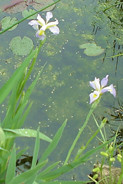 Loading... Please wait...
Loading... Please wait...- Home
- SEEDS
- SEED MIXES
- BUY PLANTS
- Info Request
-
Educational Videos
- Greenhouse Transplanting Demonstration
- Native Seed Cleaning demonstration at Ion Exchange Native Seed and Plant Nursery
- Attracting Butterflies
- Bidens - Bidens cernua Harvest Video
- Big Blue Stem Harvest
- Butterfly Milkweed Video
- Button Blazingstar - Liatris aspera Video
- Buttonbush - Cephalanthus occidentalis Video
- Canada Anemone - Anemone canadensis Harvest Video
- Cardinal Flower - Lobelia cardinalis Video
- Control Burn - Wildflower Field
- Cream Gentian - Gentiana flavida
- Culver's Root - Veronicastrum virginicum Video
- Cup Plant - Silphium perfoliatum Video
- Dormant Seeding | Planting
- Earthyman's Favorite Wildflowers Video
- Eco-Friendly Golf Course Seed Mix
- Floating Islands
- Fringed Loosestrife - Lysimachia ciliata Video
- Giant Yellow Hyssop - Agastache nepetoides Video
- Indiangrass - Sorghastrum nutans Video
- Iowa Prairie Partner Program
- Leadplant - Amorpha canescens (Potted) Video
- Meadow Blazingstar - Liatris ligulistylis
- Midland Shooting Stars - Dodecatheon meadii Video
- Native Plant Nursery Field Irrigation Experiment
- Nodding Onion - Allium cernuum Video
- Ohio spiderwort - Tradescantia ohiensis Video
- Old Man's Beard - Clematis virginiana blooms Video
- Oxeye Sunflower - Heliopsis helianthoides Video
- Prairie Spiderwort - Tradescantia bracteata
- Purple Coneflower - Echinacea purpurea Video
- Rain Garden or Water Garden Video
- Rattlesnake Master - Eryngium yuccifolium Video
- Riverbank Stabilization - Wetland Plants
- Rose Mallow - Hibiscus militaris Video
- Rosinweed - Silphium integrifolium Video
- Royal Catchfly - Silene regia
- Showy Tick Trefoil - Desmodium canadense Video
- Sneezeweed - Helenium autumnale Video
- Swamp Betony - Pedicularis lanceolata Video
- Swamp Milkweed - Asclepias incarnata Video
- Sweet Blackeyed Susan - Rudbeckia subtomentosa Video
- Tall Coreopsis - Coreopsis tripteris Video
- Urban Butterfly Garden
- Wild Bergamot - Monarda fistulosa Video
- Wild Geranium - Geranium maculatum Harvest
- Wild Goldenglow - Rudbeckia lanciniata Video
- Wild Petunia - Ruellia humilis Harvest Video
- Woodland Knotweed - Polygonum virginianum Video
- Yellow Coneflower - Ratibida pinnata Video
- Blog
- Resources
- Policies
Contact Us
Phone:
563-419-0837
or 563-535-7231
Email:
hbright@ionXchange.com
Browse Products
Add to Wish List
You Recently Viewed...
Our Newsletter
Product Description
Blue Flag Iris (Iris Shrevei) - Iris is from the Greek word for "rainbow" and shrevei is in honor of Ralph Shreve.
Commonly found in the marshy areas of the Tallgrass prairie, I. shrevei blooms from May to June and can grow to 4 feet under ideal conditions, but 2 - 3 feet is the norm. The flowers of this species are only found in the wild as blue to blue-violet; other colored irises growing in what appears to be wild conditions are garden escapes.
| Sun Exposure | Prairie, Savanna |
| Soil Moisture | Wet, Wet Mesic |
| Bloom Time | Summer May, June |
| Bloom Color | Blue |
| Max Height | 3 feet |
| Wetland Code | OBL |
| Germ Code | C(120) or M |
| Seeds Per Packet | 50 |
| Seeds Per Ounce | 1000 |
Native Americans used Blue Flag Iris to treat earaches, sore eyes, respiratory problems and liver ailments. Both Native Americans and early settlers pounded the boiled roots into a pulp and applied it as a dressing to relieve pain and swelling from sores and bruises. Early settlers also used I. shrevei occasionally to induce vomiting in order to "cleanse the intestines".
Edible Uses: Unknown
Medicinal Uses: Blue Flag contains an acrid resin with acts of the gastrointestinal tract, liver and pancreas and may cause dermatitis in some people. Large doses of Blue Flag can cause vomiting. Do not use Blue Flag while pregnant.
Herbal Uses: Unknown












